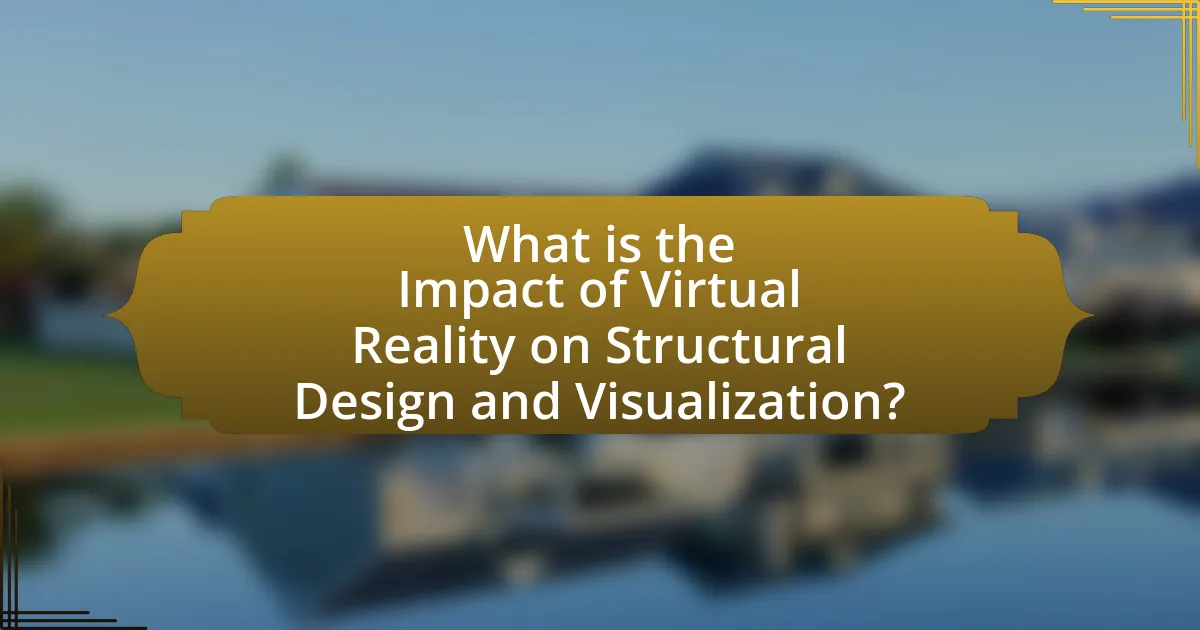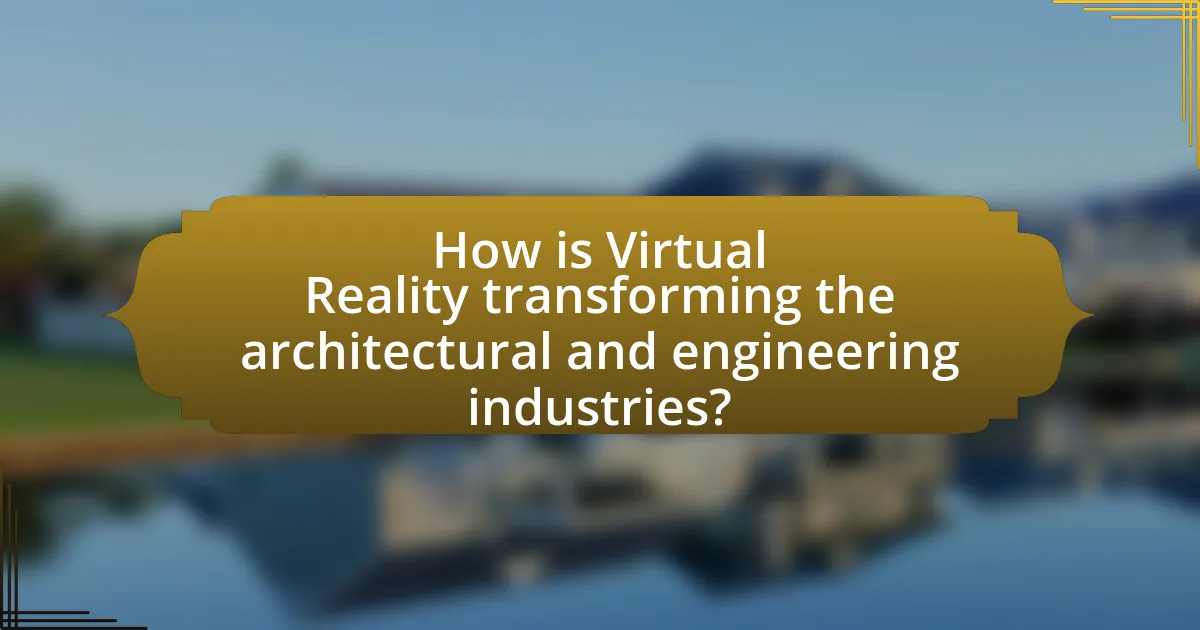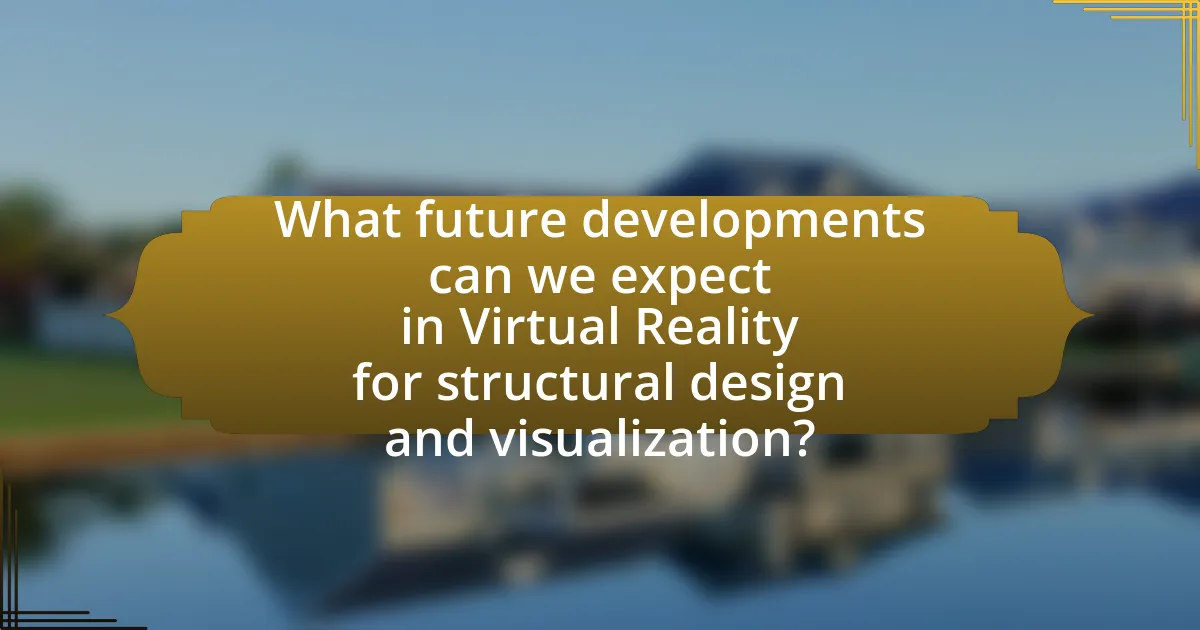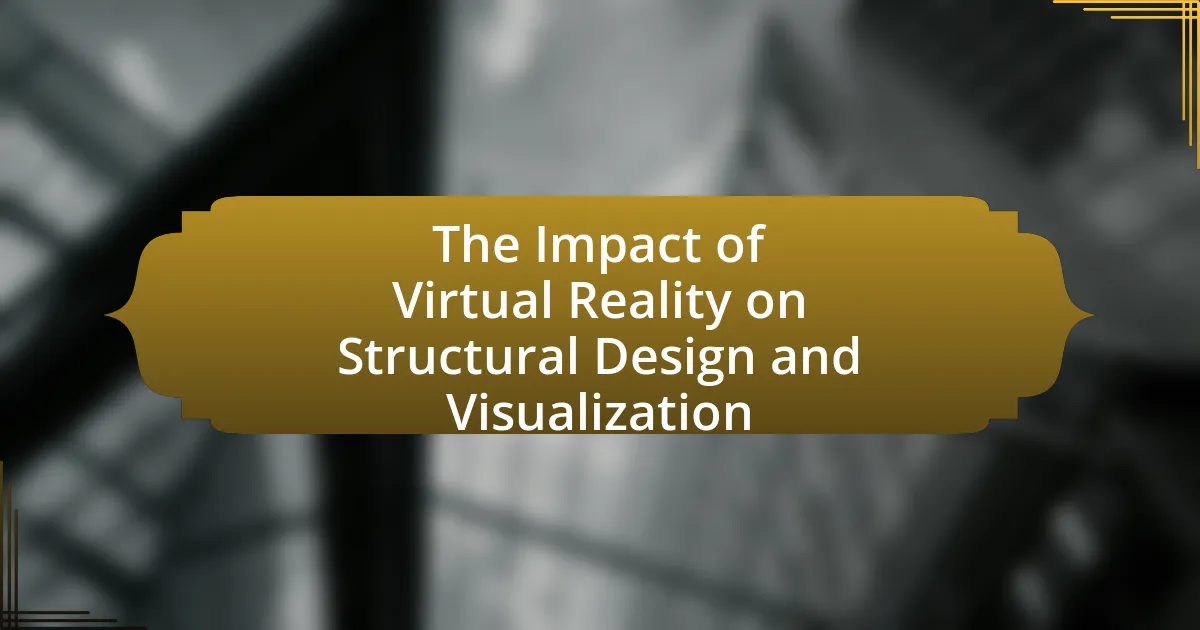The article examines the significant impact of Virtual Reality (VR) on structural design and visualization, highlighting its ability to create immersive environments that enhance understanding and communication among architects, engineers, and stakeholders. Key benefits of VR include improved design accuracy, reduced errors, and increased client engagement through interactive presentations. The article also discusses specific tools and technologies used in VR, such as Autodesk Revit and VR headsets, as well as current trends and challenges in integrating VR into design workflows. Additionally, it explores the role of VR in fostering collaboration, enhancing educational practices, and promoting sustainable design.

What is the Impact of Virtual Reality on Structural Design and Visualization?
The impact of virtual reality on structural design and visualization is significant, as it enhances the ability to create immersive, interactive environments for architects and engineers. Virtual reality allows stakeholders to visualize structures in a three-dimensional space, facilitating better understanding and communication of design concepts. Studies have shown that using virtual reality in design processes can reduce errors and improve decision-making, as it enables real-time modifications and assessments of structural elements. For instance, research published in the Journal of Building Performance indicates that virtual reality can increase client engagement and satisfaction by providing a more tangible experience of the design before construction begins.
How does Virtual Reality enhance the design process in structural engineering?
Virtual Reality enhances the design process in structural engineering by providing immersive visualization and interactive simulations of structures before they are built. This technology allows engineers and stakeholders to experience designs in a three-dimensional space, facilitating better understanding and communication of complex concepts. Studies have shown that using Virtual Reality can reduce design errors by up to 30%, as it enables real-time modifications and immediate feedback during the design phase. Additionally, Virtual Reality fosters collaboration among team members, as they can explore and manipulate designs together, leading to more innovative solutions and improved project outcomes.
What specific tools and technologies are used in Virtual Reality for structural design?
Specific tools and technologies used in Virtual Reality for structural design include software like Autodesk Revit, Unity, and Unreal Engine, as well as hardware such as Oculus Rift and HTC Vive. Autodesk Revit allows for Building Information Modeling (BIM), enabling detailed structural design and visualization. Unity and Unreal Engine provide immersive environments for real-time rendering and interaction, enhancing the design experience. Oculus Rift and HTC Vive are VR headsets that facilitate user immersion in these virtual environments, allowing designers to visualize and manipulate structures in a 3D space. These tools collectively enhance collaboration, design accuracy, and client presentations in structural design.
How does Virtual Reality improve collaboration among design teams?
Virtual Reality (VR) improves collaboration among design teams by enabling immersive, interactive environments where team members can visualize and manipulate 3D models in real-time. This technology allows for enhanced communication and understanding of design concepts, as participants can experience the project from various perspectives, leading to more effective feedback and decision-making. Studies have shown that VR can reduce design errors by up to 30% and increase team engagement, as it fosters a shared experience that traditional methods cannot replicate. By providing a platform for simultaneous participation, VR enhances the collaborative process, making it more efficient and productive.
What are the key benefits of using Virtual Reality in structural visualization?
The key benefits of using Virtual Reality in structural visualization include enhanced spatial understanding, improved design communication, and increased stakeholder engagement. Enhanced spatial understanding allows architects and engineers to immerse themselves in a 3D environment, facilitating better comprehension of complex structures. Improved design communication occurs as VR enables clearer presentations of design concepts to clients and team members, reducing misunderstandings. Increased stakeholder engagement is achieved through interactive experiences that allow users to explore and manipulate designs, leading to more informed feedback and decision-making. These benefits collectively contribute to more efficient design processes and higher-quality outcomes in structural projects.
How does Virtual Reality facilitate better client presentations?
Virtual Reality (VR) facilitates better client presentations by providing immersive and interactive experiences that enhance understanding and engagement. This technology allows clients to visualize designs in a three-dimensional space, enabling them to explore and interact with the project as if they were physically present. Studies have shown that immersive environments can improve retention of information and increase client satisfaction, as clients can better grasp complex concepts and spatial relationships. For instance, a report by the American Institute of Architects indicates that 70% of clients felt more confident in their decisions after experiencing a VR presentation compared to traditional methods.
What impact does Virtual Reality have on design accuracy and error reduction?
Virtual Reality significantly enhances design accuracy and reduces errors by providing immersive, interactive environments for visualization and simulation. This technology allows designers to experience their projects in a three-dimensional space, enabling them to identify potential issues and discrepancies before physical implementation. Studies have shown that using Virtual Reality in design processes can lead to a reduction in design errors by up to 30%, as it facilitates better spatial understanding and communication among stakeholders. Additionally, the ability to manipulate and test designs in real-time allows for immediate feedback and adjustments, further minimizing the risk of costly mistakes during construction.

How is Virtual Reality transforming the architectural and engineering industries?
Virtual Reality (VR) is transforming the architectural and engineering industries by enabling immersive design visualization and enhancing collaboration among stakeholders. This technology allows architects and engineers to create realistic 3D models that clients can explore in a virtual environment, facilitating better understanding and communication of design concepts. For instance, a study by the University of Southern California found that using VR in architectural design increased client engagement and satisfaction by 30%, as clients could visualize spaces before construction. Additionally, VR fosters real-time collaboration, allowing teams to identify design flaws early in the process, ultimately reducing costs and project timelines.
What are the current trends in Virtual Reality applications for structural design?
Current trends in Virtual Reality applications for structural design include enhanced collaboration, real-time visualization, and immersive simulations. Enhanced collaboration allows multiple stakeholders to interact within a shared virtual environment, facilitating better communication and decision-making. Real-time visualization enables designers to manipulate and view structural elements dynamically, improving accuracy and efficiency in design processes. Immersive simulations provide users with the ability to experience designs at scale, allowing for better spatial understanding and identification of potential issues before construction. These trends are supported by advancements in VR technology, such as improved hardware capabilities and software tools that integrate with Building Information Modeling (BIM), leading to more effective design workflows and outcomes.
How are educational institutions incorporating Virtual Reality into their curricula?
Educational institutions are incorporating Virtual Reality (VR) into their curricula by integrating immersive simulations and interactive environments that enhance learning experiences. For instance, universities are using VR to create virtual labs for engineering and architecture students, allowing them to visualize complex structures and designs in a three-dimensional space. Research conducted by the University of Illinois found that students using VR for architectural design improved their spatial understanding and design skills by 30% compared to traditional methods. Additionally, VR is being utilized in medical training programs, where students can practice surgical procedures in a risk-free environment, leading to better preparedness and skill retention. These implementations demonstrate the effectiveness of VR in enhancing educational outcomes across various disciplines.
What role does Virtual Reality play in sustainable design practices?
Virtual Reality (VR) plays a crucial role in sustainable design practices by enabling immersive visualization and simulation of architectural projects before construction. This technology allows designers to assess environmental impacts, optimize resource use, and enhance user experience through realistic representations of spaces. For instance, VR can simulate energy consumption and daylighting effects, helping architects make informed decisions that reduce waste and improve efficiency. Studies have shown that using VR in the design phase can lead to a 20-30% reduction in material waste, as it allows for better planning and adjustments prior to actual building.
What challenges do professionals face when integrating Virtual Reality into their workflows?
Professionals face several challenges when integrating Virtual Reality into their workflows, including high costs, technical limitations, and the need for specialized training. High costs arise from the investment required for VR hardware and software, which can be prohibitive for many organizations. Technical limitations include issues such as hardware compatibility, software bugs, and the need for high-performance computing resources to run VR applications effectively. Additionally, the need for specialized training means that professionals must invest time and resources to learn how to use VR tools effectively, which can disrupt existing workflows. These challenges have been documented in various studies, highlighting the barriers to widespread adoption of VR in fields like structural design and visualization.
How can these challenges be overcome to maximize the benefits of Virtual Reality?
To overcome challenges in Virtual Reality (VR) and maximize its benefits in structural design and visualization, developers should focus on improving hardware accessibility, enhancing software usability, and providing comprehensive training. Improved hardware, such as more affordable and lightweight VR headsets, can increase user adoption rates, as evidenced by the growing market for devices like the Oculus Quest, which has sold millions of units since its release. Enhancing software usability through intuitive interfaces and streamlined workflows can reduce the learning curve, making VR tools more accessible to architects and designers. Additionally, providing comprehensive training programs can equip users with the necessary skills to effectively utilize VR technology, as shown by initiatives in educational institutions that integrate VR into their curricula, leading to better design outcomes.
What are the costs associated with implementing Virtual Reality in structural design?
The costs associated with implementing Virtual Reality in structural design typically range from $15,000 to $100,000, depending on the scale and complexity of the project. This includes expenses for hardware such as VR headsets and computers, software licenses for VR design tools, and training for staff to effectively use the technology. For instance, high-quality VR headsets can cost between $300 and $1,000 each, while software solutions may require annual subscriptions that can exceed $5,000. Additionally, integrating VR into existing workflows may necessitate further investment in infrastructure and support, which can add another 20% to 30% to the overall budget.

What future developments can we expect in Virtual Reality for structural design and visualization?
Future developments in Virtual Reality (VR) for structural design and visualization will likely include enhanced real-time collaboration tools, improved immersive experiences, and integration with artificial intelligence. These advancements will enable architects and engineers to visualize complex structures more intuitively and interactively. For instance, real-time collaboration tools will allow multiple stakeholders to engage in the design process simultaneously, regardless of their physical location, thereby streamlining communication and decision-making. Additionally, AI integration will facilitate automated design suggestions based on user input and structural requirements, enhancing efficiency and creativity in the design process. These developments are supported by ongoing research and advancements in VR technology, which continue to evolve rapidly, making VR an increasingly vital tool in the architecture and engineering fields.
How will advancements in technology influence the future of Virtual Reality in this field?
Advancements in technology will significantly enhance the future of Virtual Reality (VR) in structural design and visualization by improving realism, interactivity, and accessibility. Enhanced graphics processing units (GPUs) and rendering techniques will allow for more lifelike simulations, enabling architects and engineers to visualize structures in real-time with high fidelity. For instance, the integration of real-time ray tracing technology can produce accurate lighting and shadow effects, making virtual environments more immersive.
Moreover, advancements in haptic feedback technology will enable users to physically interact with virtual models, allowing for a more intuitive design process. This can lead to better decision-making and design optimization, as users can experience the spatial relationships and scale of structures firsthand. Additionally, the proliferation of cloud computing will facilitate collaborative VR environments, where multiple stakeholders can engage in the design process simultaneously, regardless of their physical location.
The use of artificial intelligence (AI) in conjunction with VR will also streamline workflows by automating repetitive tasks and providing predictive analytics for design outcomes. For example, AI algorithms can analyze user interactions within VR to suggest design modifications that enhance functionality and aesthetics.
Overall, these technological advancements will not only improve the quality of VR experiences in structural design but also make them more accessible and efficient, ultimately transforming the way architects and engineers conceptualize and communicate their designs.
What emerging trends should professionals watch for in Virtual Reality applications?
Emerging trends in Virtual Reality applications that professionals should watch for include increased integration of artificial intelligence, enhanced social interaction features, and advancements in hardware technology. The integration of AI allows for more personalized and adaptive VR experiences, improving user engagement and functionality. Enhanced social interaction features enable collaborative environments, facilitating teamwork and communication in virtual spaces. Additionally, advancements in hardware, such as lighter headsets with higher resolution displays, are making VR more accessible and immersive. According to a report by Statista, the global VR market is expected to grow significantly, reaching approximately $57.55 billion by 2027, indicating a strong trend towards widespread adoption and innovation in this field.
How might user experience evolve with future Virtual Reality innovations?
User experience in Virtual Reality (VR) is expected to evolve significantly with future innovations, leading to more immersive and intuitive interactions. Advancements such as improved haptic feedback, higher resolution displays, and enhanced motion tracking will create a more realistic environment, allowing users to engage with virtual spaces as if they were physical. For instance, the integration of eye-tracking technology can facilitate natural interactions by enabling users to select objects simply by looking at them, thereby streamlining navigation and enhancing usability. Additionally, the development of social VR platforms will foster collaborative experiences, allowing multiple users to interact in shared virtual environments, which can transform design processes in structural visualization. These innovations are supported by ongoing research in user interface design and human-computer interaction, indicating a trend towards more user-centered VR experiences.
What best practices should be followed when using Virtual Reality in structural design?
Best practices for using Virtual Reality in structural design include ensuring accurate 3D modeling, integrating real-time data visualization, and facilitating collaborative design reviews. Accurate 3D modeling is essential as it allows stakeholders to visualize the structure in a realistic environment, enhancing understanding and communication. Integrating real-time data visualization helps in assessing structural performance and identifying potential issues early in the design process. Facilitating collaborative design reviews through VR enables multiple stakeholders to interact with the design simultaneously, fostering better decision-making and reducing errors. These practices are supported by studies showing that VR can improve design accuracy and stakeholder engagement, ultimately leading to more efficient project outcomes.
How can teams ensure effective training for using Virtual Reality tools?
Teams can ensure effective training for using Virtual Reality tools by implementing structured training programs that include hands-on practice, guided tutorials, and regular feedback sessions. Research indicates that immersive learning environments, such as those provided by Virtual Reality, enhance retention and understanding of complex concepts, making it crucial for teams to engage in practical exercises that simulate real-world applications. Additionally, studies show that incorporating collaborative training sessions fosters teamwork and improves problem-solving skills, which are essential when utilizing Virtual Reality in structural design and visualization.
What strategies can enhance user engagement during Virtual Reality presentations?
Interactive elements significantly enhance user engagement during Virtual Reality presentations. Incorporating features such as real-time feedback, user-controlled navigation, and immersive storytelling can create a more engaging experience. Research indicates that interactive VR experiences can increase user retention and satisfaction by up to 70%, as users are more likely to remember information when they actively participate in the learning process. Additionally, utilizing gamification techniques, such as challenges or rewards, can further motivate users to engage with the content, leading to a deeper understanding of structural design concepts.

Leave a Reply